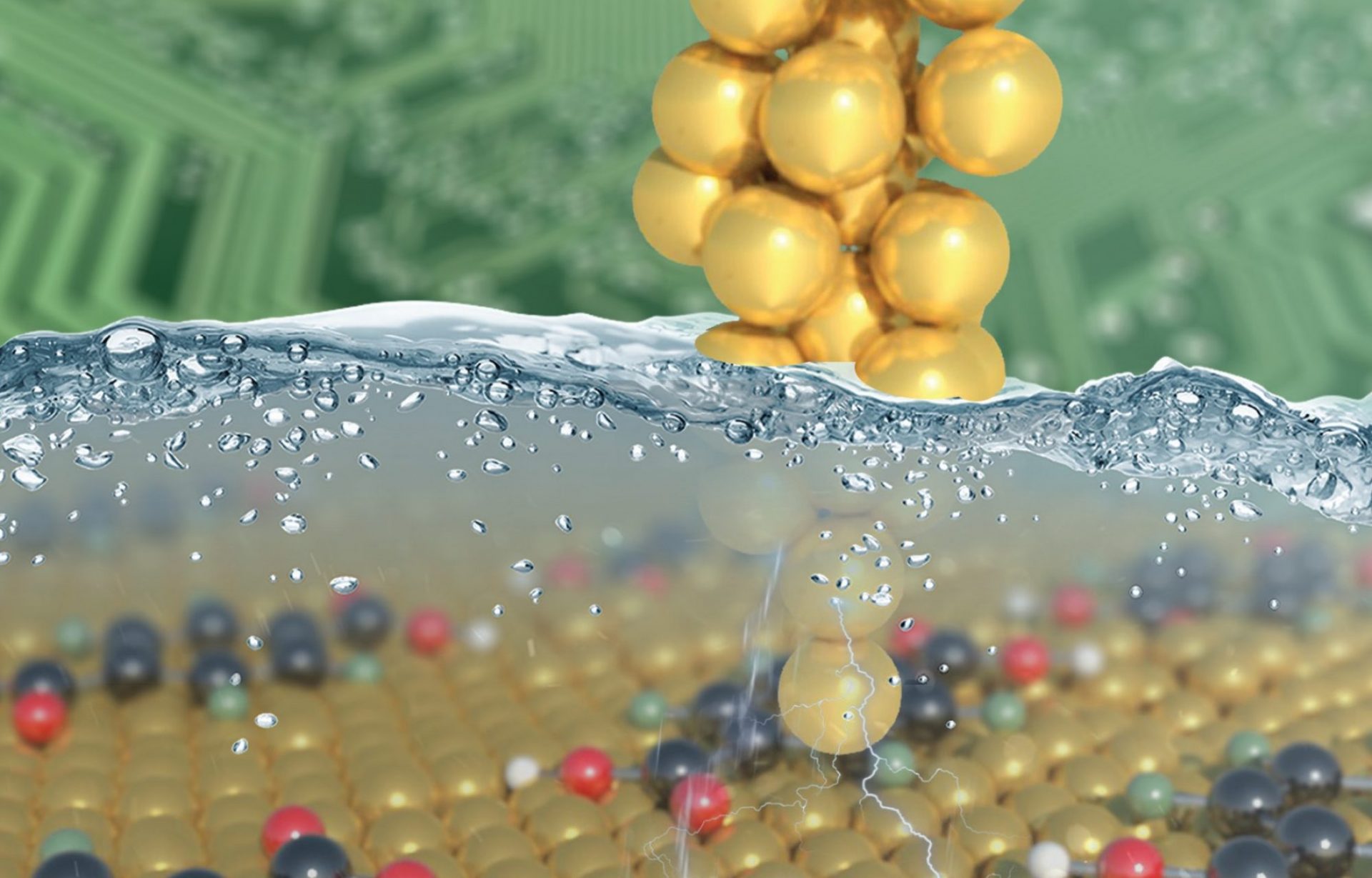1. Principles of Non-collinear Optical Parametric Amplification (NOPA)
Non-collinear optical parametric amplification (non-collinear OPA, NOPA) has been used for more than a decade to generate ultra-broadband pulses in the visible frequency range (~500-750 nm). Briefly, in the non-collinear geometry it is possible to match the projection of the group-velocity of (normally) faster-propagating idler onto the group-velocity vector of (normally) slower-propagating signal. Because the bandwidth of the OPA process in first approximation is inversely proportional to the signal-idler group-velocity mismatch (GVM), in certain non-collinear geometry GVM can approach zero, thus greatly expanding the OPA bandwidth. For more details on the principles of NOPA, please click here.
2. Ultra-broadband Near-IR NOPA based on bulk KTiOPO4 at Temple University
Our contribution was to realize that the NOPA concept can be extended to the near-IR frequency range by using other types of nonlinear optical crystals, in particular, potassium-titanyl phosphate (KTiOPO4, KTP).[1] Using a divergent, rather than collimated, seed beam, we can extend the bandwidth of amplification. This allows us to match simultaneously a set of phase matching curves (Fig. 1).[1]
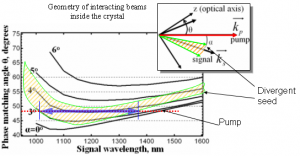
Fig. 1. Phase-matching curves for type-II OPA in KTP crystal (xz plane) calculated using SNLO software package. Shaded area shows the range of phase-matching curves at various non-collinear angles amplified simultaneously. These curves correspond to the numerous wave-vectors within the divergent signal beam (shaded area in the inset).[1]
The optical setup of our bulk KTP-based NOPA is shown here. The results of the spectral and temporal characterization of the near-IR pulses from the KTP-NOPA are shown in Fig. 2. The approach of non-collinear OPA applied to bulk KTP allowed us to generate near-IR pulses with bandwidths >2500 cm-1 and pulsewidths <40 fs. [1]
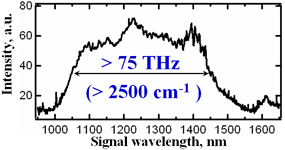
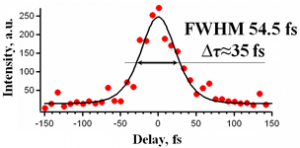
Fig. 2. Left: typical spectrum of signal pulses from KTP-NOPA. Right: autocorrelation of signal pulses after compression on a 30-µm thick BBO crystal (dots) and sech2-fit (solid line).[1]
3. Pulse-front matched KTP-NOPA at Temple University
The signal pulses amplified in a femtosecond-pumped NOPA frequently suffer from so-called pulse-front tilting as a consequence of disproportions between the beam diameters and physical lengths of pulses. This results in angular dispersion of the broadband pulses and their un-compressibility (for more details, click here).
We have corrected for this spatio-temporal distortion by applying pulse-front matching to our KTP-NOPA.[2] This allowed us to generate broadband near-IR pulses with bandwidths >30 THz and compress them further to ~25 fs (Fig. 3).[2]
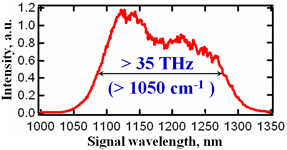
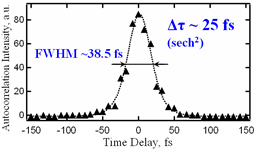
Fig. 3. Left: Spectrum of the signal pulses from the pulse-front matched KTP-NOPA. Right: autocorrelation of the signal pulses from pulse-front matched KTP-NOPA after compression (triangles) and sech2-fit (dotted line).[2]
4. Generation of >1000 cm-1 broad pulses in 2-3 micron range
For the case of 800-nm pumped KTP-NOPA, it is expected that idler pulses should be generated in the 2-3 µm region with large bandwidths.
We constructed a two-crystal KTP-NOPA employing noncollinear-geometry OPA in both crystals (for details of the optical setup, click here) [3].Our new IR NOPA has been demonstrated at 250kHz with 14% conversion efficiency [4]. Current projects involve application of the ultra-broadband mid-IR pulses to SFG spectroscopy of aqueous interfaces [5].
Reference:
1. Isaienko, O. and Borguet, E., Generation of ultra-broadband pulses in the near-IR by non-collinear optical parametric amplification in potassium titanyl phosphate. Optics Express 16(6), 3949-3954 (2008)
2. Isaienko, O. and Borguet, E., Pulse-front matching of ultrabroadband near-infrared noncollinear optical parametric amplified pulses. Journal of the Optical Society of America B 26(5), 965-972 (2009)
3. Isaienko, O. and Borguet, E., Ultra-broadband infrared pulses from a potassium-titanyl phosphate optical parametric amplifier for Vis-IR-SFG spectroscopy, in Ultrafast Phenomena XVI, Springer Series in Chemical Physics, 2009, Volume 92, Part 9, 777-779.
4. Oleksandr Isaienko, Eric Borguet, and Peter Vohringer. Efficient high repetition rate near-IR non-collinear ultrabroadband optical parametric amplification in KTiOPO4. Optics Letters 35 (22), 3832-3834 (2010).
5. Oleksandr Isaienko and Eric Borguet. Ultra-broadband high signal-to-noise sum-frequency spectrometer of aqueous interfaces based on a non-collinear optical parametric amplifier. Optics Express, 20 (1), 547-561 (2012)
